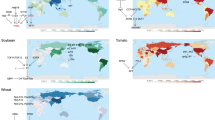Summary
The mutant genotype pg11pg11 pg12pg12-epistasis of double recessive factors-determines greater precocity of flowering. The possibility of using this mutant in the production of hybrid seed as a mean of synchronizing flowering in parent strains of different earliness is studied. The differences between mutant and green control genotypes in the characters of days to pollen shedding, pollen production, and height of plants are evaluated. Four mutant lines are considered together with their respective green near-isolines in two distinct localities and across four successive plantings.
The mutant near-isolines presented lower values than those of the green near-isolines for all the characters. The maximum reductions in days to flowring were obtained in early plantings and late maturity strains. The reduction in pollen production was about 50%. The reduced height of the mutants is explained, at least in part, by the correlation of this factor with days to flowering. The mutants did not prove to be more sensitive to the environment than their green near-isolines. Seed production was not studied since the mutant is very deficient for this character and it could therefore only be utilized as the male parent. We concluded that the mutant, could be used to synchronize flowering in the industrial production of hybrid seed.
Similar content being viewed by others
References
Anonymous, 1980. Essay mulch. A.G.P.M. Pau. France.
Bauman, L.F., 1967. Seed coating to delay emergence. 22nd Hybrid Corn Industry-research Conf.
Bosch, LL., M. Blanco, A. Alvarez & J.L. Blanco, 1979. Relationship between pg11 pg12, earliness and modification of some parts of the plants. Maize Genetics Cooperation News letter 53: 8–9.
Bosch, LL., F. Casañas & F. Nuez, 1987. Comparison among different genotypes pale green-11 pale green-12. Proceedings of 14th Eucarpia Maize and Sorghum section Congress. pp. 98–105.
Cloninger, F.D., M.S. Zuber & R.D. Horrocks, 1974. Synchronization of flowering in corn (Zea mays L.) by clipping young plants. Agronomy J. 66: 270–272.
Craig, W.F., 1977. Production of Hybrid Corn Seed. In: G.F. Sprague (Ed.). Corn and Corn Improvement, 671–719. Agronomy 18. Amer. Society of Agron, Madison.
David, S., 1981. Production de semences de maïs: que peut-on attendre du paillage plastique? A.G.P.M. Pau. France.
Gavazzi, G., C. Piccardo & L. Manzoni, 1975. A study of the effects of temperature and nutrients on the expression of chlorophyll mutants in maize. Zeitschrift für Pflanzenphysiologie 75: 381–391.
Author information
Authors and Affiliations
Rights and permissions
About this article
Cite this article
Bosch, L., Casañas, F. & Nuez, F. Synchronization of flowering in maize (Zea mays L.) by the genetic system pg11 pg12. Euphytica 41, 129–134 (1989). https://doi.org/10.1007/BF00022422
Received:
Accepted:
Issue Date:
DOI: https://doi.org/10.1007/BF00022422




